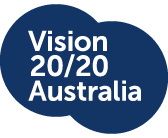Why do we need a NFIP?
The delivery of eye health and vision care, such as surgery to treat cataract, the provision of spectacles to correct refractive error or skills training in mobility for someone who has unavoidable vision loss, requires a web of interconnected parts to meet the needs of individuals around Australia. This includes: government departments and local councils; health professionals, practitioners and support staff; hospitals, clinics and rehabilitation centres; funding sources; consumer groups; universities and training centres and much more, that all needs to be integrated and coordinated to provide a system that is efficient and effective.
The National Framework for Action to Promote Eye Health and Prevent Avoidable Blindness and Vision Loss (National Framework) endorsed by all Australian Health ministers in 2005, was intended to be a starting point for national action on eye health. In the introduction to the National Framework it states that, ‘implementation of the strategies outlined in the National Eye Health Framework will be up to government agencies, health care professionals, non-government organisations, training institutions, the private sector and other interested parties working in collaboration’. Unfortunately without an implementation plan to coordinate efforts and strengthen the system, the National Framework has fallen short of its goal.
The (NFIP) will enable the sector to progress the goals of the National Framework by setting agreed performance targets, establishing measures to make sure progress is on track, coordinating the various elements within the system, and strengthening the network to ensure the capacity to deliver on the objectives. Having been adopted by all Australian Health ministers around the country with strong input from the eye health and vision care sector, the NFIP will be the game changer that we need to coordinate efforts and integrate the different parts of the system that will truly be focused on achieving outcomes for Australians across the country.
What is the state of eye health in Australia?
Accurate up-to-date statistics are always difficult to achieve. Best estimates are that there are over 575,000 people living in Australia right now who are blind or vision impaired. The situation is worse for Aboriginal and Torres Strait Islander people, with six times the rate of blindness and three times the rate of vision impairment than other Australians. In the general community, 75 per cent of vision loss is avoidable, and in Aboriginal and Torres Strait Islander communities, 94 per cent of vision loss can be avoided.
When will it be developed?
A lot of work has already been done. The Department of Health, through Vision 2020 Australia, conducted extensive consultation throughout 2013 to understand the needs from the sector to inform the NFIP. Critically, the sector has provided advice to the Department on the performance indicators that will need to be embedded within the NFIP.
In 2014, the Commonwealth Minister for Health, the Hon Peter Dutton MP, has indicated his strong support for an NFIP. He has instructed the Department to develop an initial plan for consideration in the first half of the year. This initial plan will contain the responsibilities for the Commonwealth as the basis for further development extending to the states and territories.
Who is involved?
The Minister for Health has overall responsibility for the NFIP and Minister Dutton has tasked the Primary and Mental Health Division of the Department of Health with its development. Senior staff within the Division will coordinate collaboration with the Indigenous and Rural Health Division of the Department of Health and with the Department of Social Services’ (DSS) Disability and Ageing and Aged Care divisions. Vision 2020 Australia will work with both departments to help develop the initial plan and the NFIP, and will coordinate consultation across the sector. It is important that all stakeholders are engaged and have the opportunity to ensure that the NFIP reflects the informed views of the sector.
What is the process for final endorsement?
Once the initial plan has been developed with the responsibilities for the Commonwealth, the next step will be to broaden the plan out to the states and territories. This will involve developing and drafting the NFIP for consideration by the Australian Health Ministers Advisory Council (AHMAC) and for final endorsement by the Council of Australian Governments, Standing Council on Health.
What are the key components for the NFIP?
In 2013, Vision 2020 Australia brought together the sector to consider the key components for the NFIP and a report was provided to the Department of Health. The advice from the sector recommends that the NFIP seeks to:
- Address eye health and vision care issues of national significance
- Drive the implementation of the National Framework
- Strengthen relationships between stakeholders
- Provide clear accountabilities for all actions
- Align Australia’s efforts with the World Health Assembly’s Global Action Plan 2014-19 including proposed targets and indicators.
Furthermore, within the Sector Consultation Report four areas were raised as priorities for the Implementation Plan. These included:
- Aboriginal and Torres Strait Islander eye health
- Support for people with vision loss
- Improving the evidence base
- Awareness and early detection to prevent eye disease in major conditions causing blindness and vision loss.
You can read more information in the Eye Health and Vision Care Sector Response at: https://www.vision2020australia.org.au/uploads/resource/101/Response-to-DoHA-Sector-Consultation-Final.pdf
How will it be measured?
The sector’s advice is that the NFIP be aligned with the targets and indicators contained within the World Health Assembly Global Action Plan. The Sector Consultation Report proposes national indicators that can be monitored and evaluated in the Australian context. You can find more information on targets and indicators in Appendix 5 of the Eye Health and Vision Care Sector Response .
Who to contact for more information?
For more information, contact Brandon Ah Tong, Director of Policy and Advocacy at Vision 2020 Australia, on bahtong@vision2020australia.org.auor 03 9656 2020.
